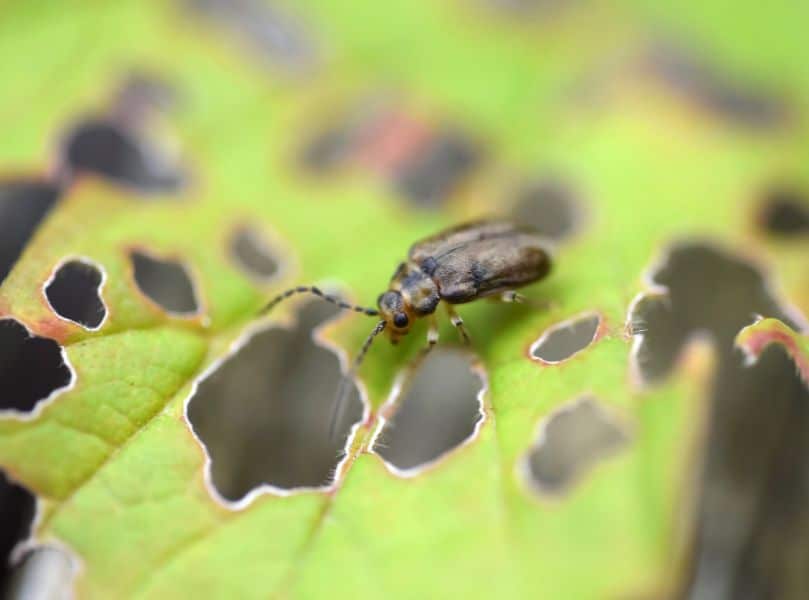
Pest Alert! Effective Viburnum Leaf Beetle Control for Your Trees
When it comes to keeping your landscape healthy, one of the biggest threats to your Viburnum plants is the Viburnum leaf beetle. This invasive pest has quickly spread across many regions, leaving behind serious damage that can defoliate trees and weaken their overall health. If left untreated, this insect infestation can ruin the beauty of your shrubs, spread to nearby vegetation, and leave your garden vulnerable to other viburnum pests and viburnum plant diseases.
In this blog, we’ll walk you through everything you need about viburnum leaf beetle control—from identification to prevention and treatment methods.
What Is the Viburnum Leaf Beetle?
The Viburnum leaf beetle (Pyrrhalta viburni) is a destructive pest that feeds exclusively on Viburnum plants. Both larvae and adult beetles cause severe damage by chewing through leaves, often leaving behind skeletonized foliage.
- Larvae Stage – They emerge in spring and feed on young leaves, quickly stripping away tissue.
- Adult Stage – By mid-summer, adult beetles continue feeding on the foliage and can persist well into the fall season.
Their life cycle allows them to attack plants at multiple points throughout the year, making early detection critical.
Signs of Viburnum Leaf Beetle Damage
If you suspect an infestation, look for these telltale symptoms of viburnum leaf beetle damage:
- Skeletonized leaves with veins remaining intact
- Browning or curling foliage
- Premature leaf drop
- Weakened plant growth
- Defoliation (often complete within a single growing season)
Repeated infestations weaken shrubs and make them more susceptible to secondary viburnum plant diseases.
Why Viburnum Pests Are a Serious Threat
Unlike minor pests that cause cosmetic damage, Viburnum leaf beetles can kill entire shrubs within two to three years. The combination of larvae and adult feeding cycles leaves little time for the plant to recover, and once weakened, the shrubs often fall victim to other viburnum pests and fungal infections.
This is why implementing strong viburnum leaf beetle control measures is so crucial for long-term plant health.
Effective Viburnum Leaf Beetle Control Methods
1. Manual Removal
For minor infestations, hand-picking larvae or adults off the plant and destroying them can help reduce populations. Pruning and discarding heavily infested branches is another effective measure.
2. Pruning Egg-Laden Twigs
During the fall and winter, adult beetles lay eggs inside twigs. By carefully pruning and disposing of these egg-infested branches before spring, you can significantly reduce the beetle population for the next season.
Pro Tip: If pruning seems overwhelming, hiring a professional tree maintenance company can save time and effectively handle the problem.
3. Insecticidal Treatments
- Horticultural Oils – Applying dormant oil in late winter or early spring can suffocate overwintering eggs.
- Insecticidal Soaps – Useful for targeting larvae in the spring when they are most vulnerable.
- Systemic Insecticides – These are absorbed into the plant tissue, protecting the foliage from feeding larvae and adults.
Always follow product instructions carefully and, if unsure, seek professional help.
4. Biological Controls
Encouraging natural predators, such as lady beetles and predatory mites, can help manage beetle populations. While not a complete solution, this eco-friendly method can be used alongside other treatments.
5. Planting Resistant Varieties
Some Viburnum species are more resistant to beetle damage. For example, Viburnum carlesii and Viburnum plicatum varieties tend to be less susceptible than others. If you’re planting new shrubs, consider these options to reduce long-term risks.
Preventing Viburnum Plant Diseases
A major consequence of severe viburnum leaf beetle damage is the increased risk of viburnum plant diseases. Weakened plants are prone to fungal infections, root rot, and bacterial diseases.
Here’s how to minimize these risks:
- Water Properly – Avoid overwatering, which promotes fungal growth.
- Maintain Air Circulation – Prune regularly to allow airflow between branches.
- Fertilize Wisely – Use balanced fertilizers to strengthen plants against pests and diseases.
- Mulch Strategically – A layer of mulch helps retain moisture but keep it away from the trunk to prevent rot.
Professional Tree Care Solutions
Sometimes, the damage caused by viburnum pests and beetles is beyond what DIY methods can handle. In such cases, hiring a professional is the best choice.
- For seasonal services like pruning, removal of infested branches, and overall tree health assessments, a tree maintenance company can provide expert care.
- If your trees or shrubs are severely infested and need to be removed, you may need Holiday tree removal to prevent the beetles from spreading to other areas of your yard.
These professionals not only treat infestations but also help create a maintenance plan that prevents future problems.
Long-Term Tree & Shrub Care Tips
To protect your Viburnum shrubs from pests and diseases year after year, keep these long-term strategies in mind:
- Inspect plants regularly, especially in spring and summer.
- Prune strategically during dormant seasons.
- Remove and dispose of fallen leaves to eliminate overwintering beetles.
- Water and fertilize correctly to maintain plant resilience.
- Schedule professional inspections at least once a year.
The Viburnum leaf beetle may be small, but its impact on your landscape can be devastating. Recognizing early signs of viburnum leaf beetle damage, understanding how these viburnum pests operate, and implementing proper viburnum leaf beetle control methods are the best ways to protect your shrubs.
If the infestation is severe, don’t hesitate to consult a professional tree maintenance company or consider Holiday tree removal to safeguard the rest of your landscape.
By combining prevention, treatment, and professional care, you can keep your Viburnum shrubs healthy, beautiful, and pest-free for years to come.

